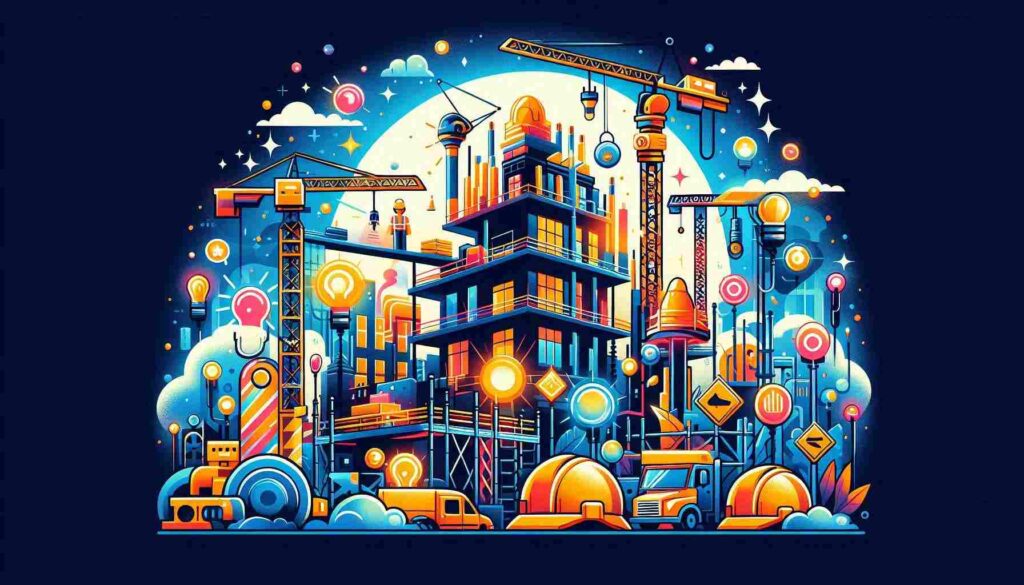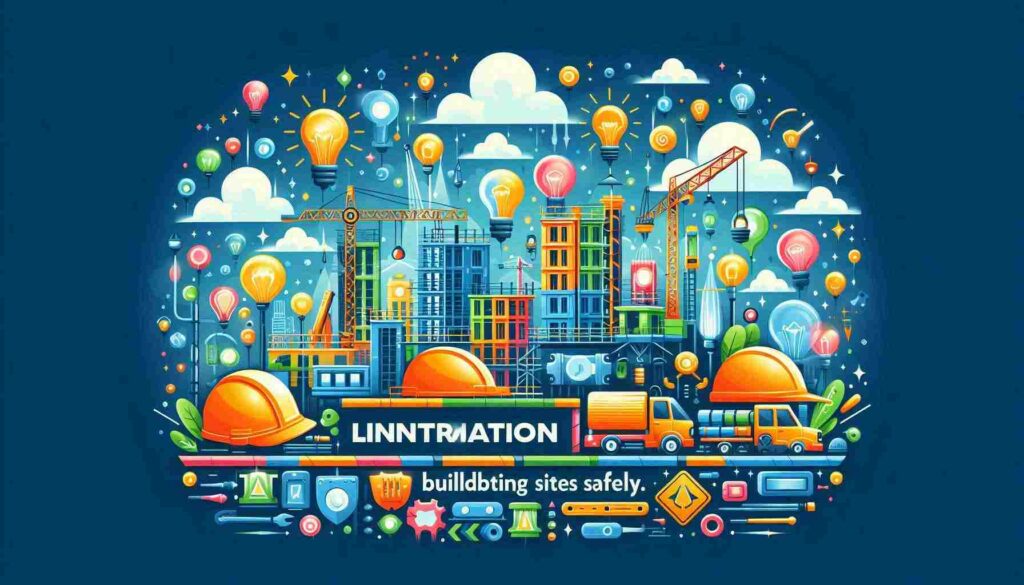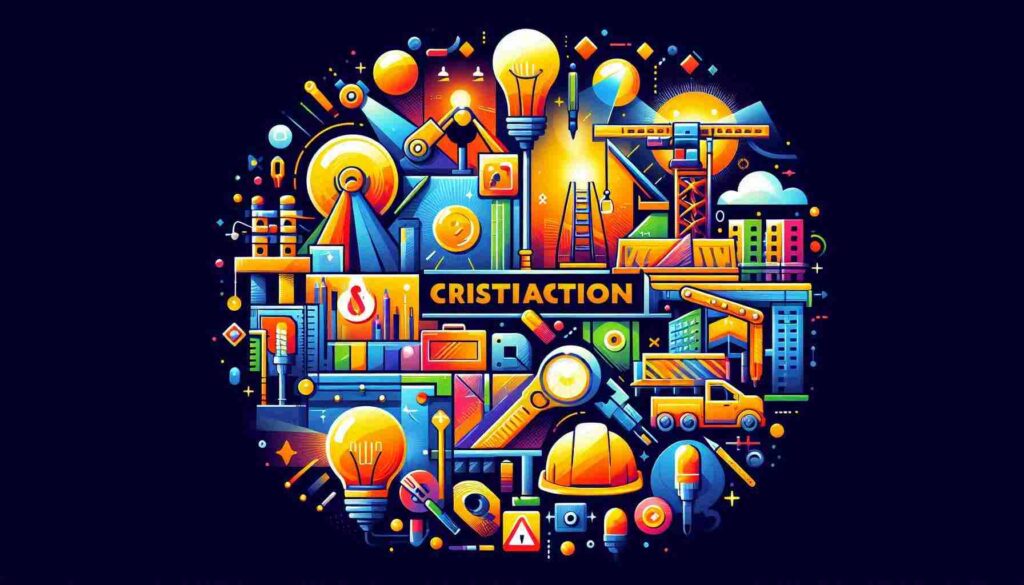Have you ever driven past a construction site at night and marveled at the bright lights illuminating the area? Those aren’t just any lights – they’re construction lights, the unsung heroes of building sites everywhere. These powerful illumination systems are essential for keeping workers safe and projects on track, even when the sun goes down.
Construction lights play a crucial role in the building industry. They not only extend working hours but also significantly enhance safety on job sites. Without proper lighting, construction work would be limited to daylight hours, slowing down projects and increasing costs. More importantly, inadequate lighting can lead to accidents, injuries, and even fatalities.
Key Takeaways
- Construction lights are specialized illumination systems designed for building sites
- They enhance safety, extend working hours, and improve productivity
- Proper lighting is essential for preventing accidents and ensuring worker well-being
- Various types of construction lights are available, each suited for different purposes
- Choosing the right lighting solution depends on factors like project size, duration, and specific requirements

Understanding Construction Lights
Construction lights, also known as work lights or job site lighting, are specially designed illumination systems used in building and construction environments. These lights are built to withstand harsh conditions, provide powerful illumination, and meet safety standards specific to construction sites.
There’s a wide variety of construction lights available in the market, each with its own unique features and applications. From portable flood lights to towering light towers, the options are vast and varied. Let’s dive into some of the most common types:
Portable Flood Lights
These versatile lights are a staple on many construction sites. They’re lightweight, easy to move around, and can be set up quickly. Portable flood lights are perfect for illuminating smaller areas or for tasks that require focused lighting. They’re often LED-based, which means they’re energy-efficient and long-lasting.
I remember working on a home renovation project where these little powerhouses saved the day. We were working late into the night to finish a kitchen remodel, and these portable flood lights allowed us to see every detail clearly, even in the tightest corners.
Light Towers
When you need to light up a large area, light towers are the way to go. These tall structures can illuminate vast spaces, making them ideal for big construction projects, road work, or outdoor events. They typically have multiple powerful lamps mounted on an extendable mast, which can be raised to heights of 20 feet or more.
Light towers come in various types, including diesel-powered, solar-powered, and hybrid models. The choice often depends on the project’s duration, location, and environmental considerations. I’ve seen these giants in action on highway construction projects, where they turned night into day, allowing work to continue around the clock.
String Lights
Don’t let their festive appearance fool you – string lights are workhorses on construction sites. These long strands of lights are perfect for providing general illumination over a wide area. They’re especially useful in enclosed spaces like building interiors or tunnels under construction.
String lights are easy to install and can be daisy-chained to cover large areas. They’re also relatively inexpensive, making them a cost-effective lighting solution for many projects. On a recent warehouse renovation project, we used string lights to illuminate the entire interior space, creating a well-lit environment for all the different trades to work efficiently.
Area Lights
Area lights are designed to provide broad, even illumination over a specific area. They’re often mounted on stands or poles and can be adjusted to direct light where it’s needed most. These lights are great for illuminating workspaces, storage areas, or any location that requires consistent, bright light.
Many area lights now use LED technology, which offers benefits like energy efficiency, long life, and instant-on capability. I’ve found these particularly useful on night-time road construction projects, where they provide clear visibility for workers without causing glare for passing drivers.

The Importance of Proper Lighting in Construction
Now that we’ve covered the types of construction lights, let’s talk about why they’re so crucial. Proper lighting on a construction site isn’t just about being able to see what you’re doing – it’s a matter of life and death.
Safety First
The most important reason for having good lighting on a construction site is safety. Poor visibility can lead to accidents, from simple trips and falls to more serious incidents involving heavy machinery or power tools. Adequate lighting helps workers identify hazards, navigate safely around the site, and perform their tasks with precision.
I once worked on a project where the lighting was subpar, and it was a nerve-wracking experience. Every shadow seemed like a potential hazard, and simple tasks became unnecessarily stressful. After we upgraded the lighting, the difference in safety and morale was night and day (pun intended!).
Extended Working Hours
Construction lights allow work to continue beyond daylight hours, which can be crucial for meeting project deadlines. In some cases, night work is necessary to avoid disrupting daytime activities, such as in urban construction projects or road work.
Extended working hours can also help to accelerate project timelines. I’ve been involved in projects where we were able to shave weeks off the schedule by implementing effective night-time lighting and running two shifts. It’s amazing how much more can be accomplished when you’re not limited by daylight.
Improved Productivity
Good lighting doesn’t just extend working hours – it also improves the quality and efficiency of work. When workers can see clearly, they can work faster and make fewer mistakes. This is especially important for tasks that require precision, like electrical work or finishing.
I’ve noticed that well-lit sites tend to have a more positive atmosphere too. Workers feel more confident and comfortable, which naturally leads to better productivity. It’s a simple equation: better visibility equals better work.
Compliance with Regulations
Proper lighting isn’t just a good idea – it’s often a legal requirement. Many countries have specific regulations about lighting levels on construction sites. For example, in the United States, OSHA (Occupational Safety and Health Administration) has guidelines for minimum illumination intensities for different construction activities.
Failing to meet these standards can result in fines, project delays, or even site shutdowns. I’ve seen inspectors pull out light meters to check illumination levels, and believe me, you don’t want to be caught short in this area.
As we’ve seen, construction lights are far more than just a convenience – they’re a critical component of any building project. In the next section, we’ll explore how to choose the right lighting solution for your specific needs, and discuss some best practices for implementation. But before we dive into that…

Choosing the Right Construction Lighting Solution
Alright, let’s talk about picking the perfect lighting setup for your construction site. It’s not a one-size-fits-all situation, and trust me, I’ve learned this the hard way. There’s a bunch of factors you gotta consider:
Project Size and Duration
The scale of your project is gonna be a big deciding factor. For a small, quick job, you might get away with a few portable flood lights. But if you’re working on a massive project that’ll take months or even years, you’ll probably want to invest in some heavy-duty light towers.
Power Source Availability
This is crucial, folks. I remember one time we showed up to a remote site with a bunch of electric lights, only to find there was no power source for miles. Talk about a facepalm moment! Consider whether you’ll have access to electricity, or if you need to go with battery-powered or generator-powered options.
Mobility Requirements
How often will you need to move your lights around? If your work area is constantly changing, go for portable options. But if you’ve got a fixed work zone, you can set up more permanent lighting solutions.
Environmental Conditions
Don’t forget about Mother Nature! If you’re working in an area with harsh weather, you’ll need lights that can stand up to the elements. I’ve seen cheap lights get fried in a single thunderstorm – not fun when you’re on a deadline.
Task-Specific Lighting Needs
Different jobs need different types of light. For detailed work, you might need focused, high-intensity lighting. For general area illumination, a broader, more diffused light might be better.
Best Practices for Implementing Construction Lighting
Now that you’ve got your lights, let’s talk about how to use ’em right. Here are some tips I’ve picked up over the years:
Strategic Placement
Don’t just plonk your lights down anywhere. Think about where the shadows will fall and try to minimize them. Aim for even illumination across the whole work area. And for Pete’s sake, don’t blind your workers or create glare for nearby traffic!
Regular Maintenance
Lights need love too, y’know. Keep ’em clean, check for damage regularly, and replace bulbs before they burn out. A little TLC goes a long way in keeping your site bright and safe.
Backup Plans
Always have a Plan B. Keep some spare bulbs and portable lights on hand. You never know when a light might go out, and you don’t want work grinding to a halt because of it.
Energy Efficiency
Look, I’m all for saving the planet (and some cash). LED lights are awesome for this – they use way less energy and last forever. Plus, they’re tough as nails, which is perfect for construction sites.
Safety First, Always
Make sure all your lighting equipment is properly grounded and protected from water. And for the love of all that’s holy, train your workers on how to use and maintain the lights safely!
So there you have it, folks. Construction lights might not be the most glamorous part of a building project, but they’re absolutely crucial. They keep our workers safe, our projects on track, and our sites running smoothly long after the sun’s gone down. Next time you pass a brightly lit construction site at night, give a little nod to those hardworking lights. They’re the unsung heroes of the construction world, making sure we can keep building, no matter what time it is.
Remember, good lighting isn’t just about seeing what you’re doing – it’s about creating a safe, efficient, and productive work environment. So don’t skimp on your lighting setup. Your workers (and your project timeline) will thank you for it!
Frequently Asked Questions
1. What’s the difference between construction lights and regular outdoor lights?
Construction lights are built tougher than your average outdoor light. They’re designed to withstand the rough and tumble of a construction site, with features like impact-resistant casings and weather-proof seals. They’re also typically brighter and can cover larger areas. Regular outdoor lights might not cut it in terms of durability or illumination power on a construction site.
2. How many lumens do I need for a construction site?
This really depends on the size of your site and the type of work you’re doing. As a general rule, OSHA recommends a minimum of 5 foot-candles (54 lux) for general construction areas. For tasks requiring more detailed work, you might need up to 10 foot-candles (108 lux) or more. It’s always best to consult with a lighting professional to get the right setup for your specific needs.
3. Are LED lights better for construction sites?
In my experience, yes! LED lights have a bunch of advantages for construction sites. They’re energy-efficient, which can save you a ton on power costs for long-term projects. They also last way longer than traditional bulbs, meaning less maintenance. Plus, they’re tough and can handle vibrations and impacts better than other types of lights. The initial cost might be higher, but they usually pay for themselves in the long run.
4. How often should construction lights be inspected?
You should be giving your lights a quick once-over every day before use. Look for any obvious damage or wear and tear. More thorough inspections should be done weekly, checking all connections, looking for any water ingress, and testing all functions. And don’t forget about those portable lights – they should be inspected every time they’re moved to a new location.
5. Can construction lights cause glare for nearby residents or traffic?
Absolutely, and this is something you need to be really careful about. Improperly aimed lights can cause serious glare issues, which can be annoying for neighbors and downright dangerous for traffic. Always aim your lights downward and use shields or diffusers if necessary. If you’re working in a residential area or near roads, consider using directional lights that focus the illumination where you need it without spilling over into surrounding areas.
6. What’s the best way to light up a large construction site?
For big sites, light towers are usually your best bet. These bad boys can light up a huge area from a single point. You’ll want to place them strategically around the site to ensure even coverage. For really large sites, a combination of light towers and smaller, more focused lights often works well. Don’t forget about those hard-to-reach areas – string lights can be great for illuminating interior spaces or narrow corridors.
7. Are there any regulations about construction site lighting?
You bet there are! In the U.S., OSHA has specific guidelines about minimum illumination levels for different types of construction work. Other countries have their own regulations. It’s super important to familiarize yourself with local requirements. Not following these rules can result in fines or even site shutdowns. When in doubt, consult with a safety professional or lighting expert.
8. How do I choose between wired and battery-powered construction lights?
This really comes down to your specific situation. Wired lights are great if you have a reliable power source and don’t need to move the lights often. They provide consistent power without worrying about battery life. Battery-powered lights, on the other hand, offer more flexibility. You can use them anywhere, even if there’s no power source nearby. They’re also safer in some ways, as there are no cords to trip over. The downside is that you need to keep an eye on battery levels and recharge or replace batteries regularly.
9. Can construction lights be used in wet conditions?
Many construction lights are designed to be water-resistant or even waterproof. Look for lights with an IP (Ingress Protection) rating. An IP65 rating or higher means the light can withstand water jets from any direction. However, even with waterproof lights, you need to be careful about electrical connections. Make sure all power sources and connections are properly protected from water. And remember, water-resistant doesn’t mean submersible – don’t go dunking your lights in puddles!
10. How can I make my construction site lighting more environmentally friendly?
Great question! There are several ways to green up your lighting. First, opt for LED lights – they’re way more energy-efficient than traditional options. Consider solar-powered lights for areas that get good sun exposure during the day. Use timers or motion sensors to ensure lights are only on when needed. And don’t forget about light pollution – use focused beams and proper shielding to minimize unnecessary light spill. Lastly, make sure to dispose of old bulbs and batteries properly. Many components can be recycled, so check with your local waste management facility for guidelines.






